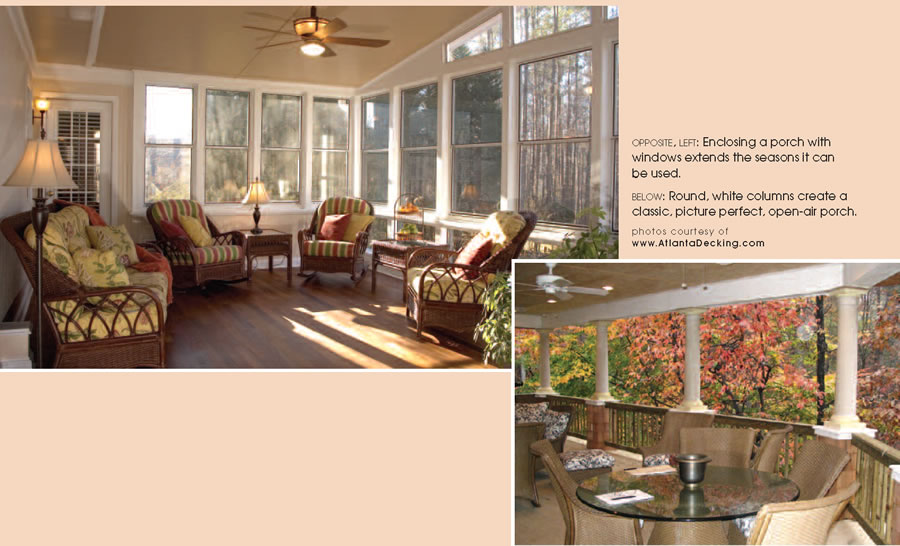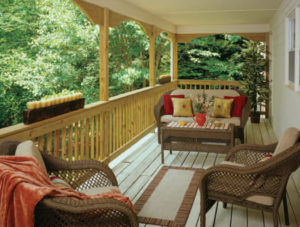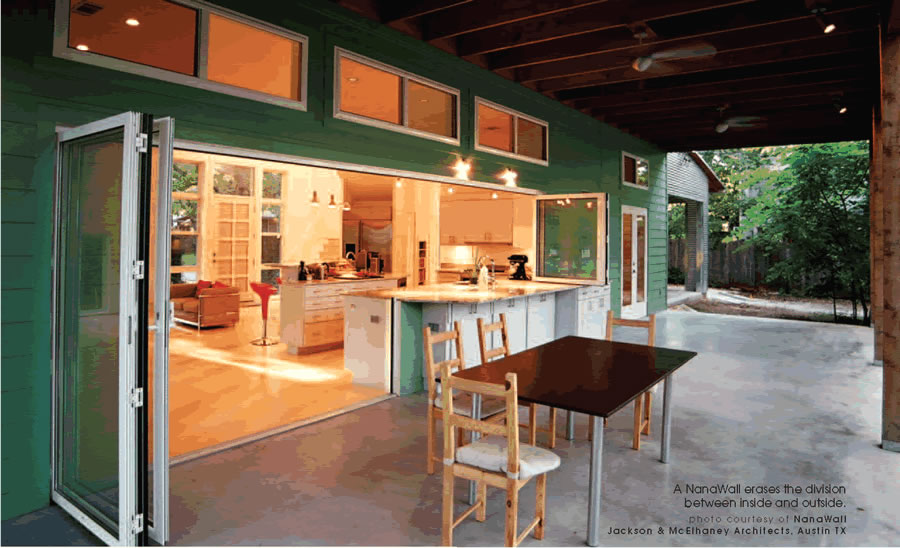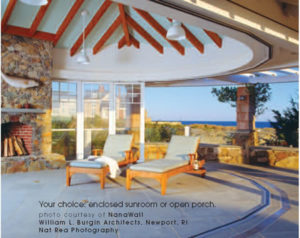The porch beckons to every generation. For a child, it is a dry place to play when it is raining. For a young couple, it is a quiet spot to catch up on each other’s day. Busy professionals find it a low-stress answer to casual entertaining. Retirees enjoy their morning coffee and the newspaper on the porch. Upon occasion, Nancy Moore of the Porch Company in Nashville, Tennessee, even includes a special ledge for the family cat.
Size and Location
A shallow front porch can bring a warm, welcoming sense to a home. But Design Basics Custom Home Designer Carl Cuozzo reports most people want their back porches to be 8 - 10 feet deep, so they can easily arrange a table and chairs. According to Moore, the average porch today runs between 300 and 350 square feet.
A south-facing porch may be ideal in a cooler northern state, but foolish in Arizona. “Locating a porch on the south side of a home may also reduce the amount of direct light that enters the adjacent room,” notes Cuozzo. “You can get around this somewhat by making the porch taller, but you need to remember that a taller porch will offer less protection when it’s windy or raining. Because a home receives indirect light on the north side, a northern porch won’t affect light inside the home as much.

“The porch’s effect on the home’s view is another consideration, especially if you want to use longer windows in the bordering room. One solution is to design the porch off to the side so it doesn’t interfere with a great room’s view, for instance. Of course, that’s not a big deal if there isn’t a particularly impressive view in the first place.
“Popular in the 1920s, screened sleeping porches are enjoying a resurgence. They offer a way to relive simpler times, enjoy fresh air and relish the great outdoors. Of course, in our day they may require a second-story location for security purposes and they’re more common in quiet, private settings, away from the city."
Special Features
“Outdoor kitchens with built-in grills, refrigerators and sinks are in demand,” Moore says, “but I often suggest homeowners consider less permanent fixtures than stone grills and countertops. Many of them can remember their parents’ 1950s brick grill that sat in the back yard for 40 years before somebody finally demolished it. So I like to build these elements out of wood that can easily be rolled away when they become dated.”
“There are outdoor kitchen units available that function without outdoor plumbing,” Cuozzo adds. “Just hook your potable drinking hose up to it, and you have a sink, grill and refrigerator ready to go. Bars with stools are also common.
“Fireplaces on porches continue to be a ‘hot’ item. Heat & Glo makes a see-through fireplace with one side on the inside of the house and the other on the outside. You can also put wood-burning boxes outside with a hearth and chimney.”
Moore agrees: “We’re installing a fireplace on every third porch, though in actuality, they provide more beauty and ambience than function. If you get close to the fire, you’ll feel a little warmer, but you just can’t heat a room without walls.”
Flooring

Who says you’re too old for a tree house? photo courtesy of www.AtlantaDecking.com
In addition to traditional tongue-and-groove wood floors, homeowners can choose from a variety of flooring materials including brick, stone, tile, wood, composites and concrete. Budget, maintenance, the porch’s foundation and the style of the home all need to be considered when choosing a floor.
“Pier-and-beam foundations typically support wood porches,” explains Moore. “Masonry floors usually require masonry foundations. If you use a wood foundation for a masonry floor, you’ll really have to beef it up so it doesn’t move.
“For heavier tile and stone flooring, the structure needs to be specially formed to hold the weight and sloped well to allow water run-off. An additional sub floor may also be required. Concrete slab foundations, standard in most new homes, are perfect for tile, stone and brick.”
“Notwithstanding foundation cost, concrete is the cheapest flooring you can use,” notes Cuozzo. “And it’s very versatile. The only negative I’ve heard is that stamping can get really slick because water stays in the crevices – especially problematic in areas with freezing temperatures. Another option is to use colored concrete with a cut pattern and a brushed finish as accents. Of course, coloring and cutting adds to the cost. Tile can also become slick when wet.
“Low-maintenance composites are very popular. TimberTek® now offers expanded color choices, including the old gray ‘battleship’ color so many porches used to have.
“In the Midwest, a lot of people still choose real cedar and put a finish on it,” continues Cuozzo. “They like the old porch feel you get with the ‘clickclack’ sounds.”
“Ninety percent of the time, we use a tongue-and-groove cypress floor in Tennessee,” Moore remarks. “It looks like an interior floor; it’s easier to maintain; and it’s low cost. The only time we don’t use it is if the porch is really low to the ground – making a masonry floor more appropriate.
“No matter what material you use, the floor must be sloped and have a drainage system so that water won’t stand on it,” Moore continues. “As long as water runs off, you can use cypress, yellow pine, spruce or cedar and it won’t rot. Of course, we always seal our floors with a good penetrating, oil-based finish.”
Lighting
Since one of the most popular times to use porches is in the evening, good lighting is essential. The Porch Company utilizes a variety of techniques. “Because many of the porches we do have vaulted ceilings with exposed rafters, there’s no cavity for recessed can lighting,” says Moore. “So we mount lights on the porch’s posts. “We usually have a collar type structural beam on the ceiling; we put track lights on top of that column and shine them upward. This highlights the pretty ceiling and the light shines down, providing a nice, soft ambient lighting.
“Finally, we mount an outlet on top of the header where you can’t see it, making it easy for homeowners to string Christmas lights. The outlet is controlled by a switch so homeowners can easily turn them on and off. “Our clients can create different moods because we always put the lights on separate dimmer switches,” Moore adds.
Furniture
The right furniture, properly arranged adds comfort and style to any porch. Moore is not fond of built-ins. “Even though they work well in tight spaces, I tend to advise against them because they limit you to one arrangement. One of the beauties of porches is they’re so versatile. Sometimes I set my own porch up with four small dinner tables, and other times I create a single seating area.”
Textile companies are broadening that versatility. With new weather resistant fabrics, homeowners no longer have to settle for uncomfortable deck chairs or pull in all the furniture every time rain threatens. Instead, the porch easily becomes an outdoor refuge, with the comfort and style of the indoors.

Finishing Touches
A few final considerations can impact comfort. The first: to screen or not to screen. “Open-air porches have a more formal, dressy appearance; you rarely see a screened porch in the front of the home,” says Moore. “But even if it’s a back porch, you may not choose to screen it if you live in a locale where bugs aren’t too much of a problem. If you can sit out on your porch at 5 o’clock at night and not get eaten up, then great! Go with an open-air porch. If not, build a screened-in porch.”
 Although some homeowners may prefer permanent screened porches to keep bugs out, companies like Phantom™ Screens offer an alternative. With options for screen doors, windows and porches, these screens can roll away at the touch of a button to allow guests to enjoy a better view.
Although some homeowners may prefer permanent screened porches to keep bugs out, companies like Phantom™ Screens offer an alternative. With options for screen doors, windows and porches, these screens can roll away at the touch of a button to allow guests to enjoy a better view.
“Fans can also keep bugs away. Mosquitoes don’t fly against the wind,” Moore notes. “Of course, they provide a refreshing breeze as well. We often include both overhead and wall-mounted fans. Homeowners can still augment them with fans on stands to get right down at the seating level. As an added bonus, fans are now available in a wide range of stylish looks from vintage to contemporary.”
The NanaWall® can give a porch extra flexibility. This large glass folding system closes to create a weather-tight sunroom in the winter and opens up to become an outdoor porch for summer entertaining. The NanaScreen, a collapsible pleated screen system on a single floor track, complements the NanaWall; the NanaWall brings the outdoors in and the NanaScreen keeps the insects out. Every NanaWall is custom made to a homeowner’s specifications. Prices vary depending on materials and design configuration.
Relaxing on a porch is a simple pastime, but with the wealth of options available today, planning one can require some time and research. To ensure a satisfying outcome, Moore recommends hiring a company that specializes in porch construction, getting a fixed bid and working off a detailed set of plans.


